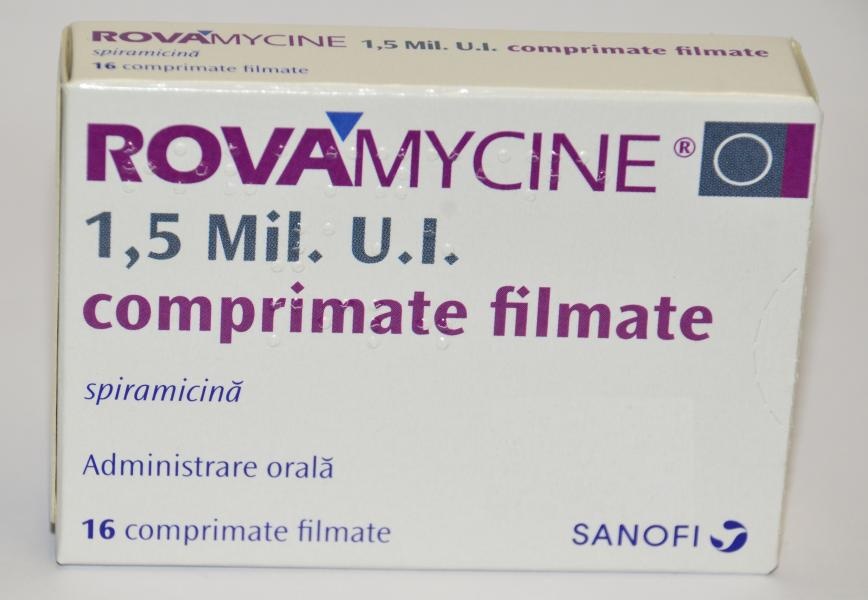

ROVAMYCINE 1.5 million IU FILM-COATED TABLETS

Ask a doctor about a prescription for ROVAMYCINE 1.5 million IU FILM-COATED TABLETS

How to use ROVAMYCINE 1.5 million IU FILM-COATED TABLETS
Introduction
Package Leaflet: Information for the Patient
Rovamycine 1.5 Million IU Film-Coated Tablets
Spiramycin
Read the Entire Package Leaflet Carefully Before Starting to Use the Medication
- Keep this package leaflet, as you may need to read it again.
- If you have any questions, consult your doctor or pharmacist.
- This medication has been prescribed to you and should not be given to others, even if they have the same symptoms, as it may harm them.
- If you consider any of the side effects you are experiencing to be serious or if you notice any side effect not mentioned in this package leaflet, inform your doctor or pharmacist. See section 4.
Package Leaflet Contents:
- What is Rovamycine and what is it used for
- What you need to know before taking Rovamycine
- How to take Rovamycine
- Possible side effects
- Storage of Rovamycine
- Package contents and additional information
1. What is Rovamycine and what is it used for
Rovamycine belongs to a group of medications called macrolides. Antibiotics stop the growth of bacteria that cause infections.
Antibiotics are used to treat bacterial infections and are not effective against
viral infections such as the flu or the common cold.
It is essential to follow the instructions regarding dosage, administration interval, and treatment duration indicated by your doctor.
Do not store or reuse this medication. If you have any leftover antibiotic after completing the treatment, return it to the pharmacy for proper disposal.Do not throw away medications down the drain or in the trash.
Rovamycine is used to treat infections caused by susceptible germs in:
- Tonsillitis (infection of the throat). Pharyngitis (infection of the pharynx).
- Sinusitis (infection of the paranasal sinuses around the forehead, cheeks, and eyes).
- Otitis (infection of the ear).
- Infections of the oral cavity.
- Gonococcal infections (sexually transmitted infections).
- Toxoplasmosis (infection caused by a parasite).
2. What you need to know before taking Rovamycine
Do not take Rovamycine
If you are allergic to the active substance or any of the other components of this medication (listed in section 6).
Warnings and precautions
Consult your doctor or pharmacist before starting to take Rovamycine.
- Caution should be exercised in patients with known risk factors for cardiac arrhythmias, such as QT interval prolongation: hypocalcemia, hypomagnesemia, congenital QT interval prolongation, heart disease, and concomitant use of medications with a known effect of QT interval prolongation.
Elderly patients, neonates, and women may be more sensitive to the effect of QT interval prolongation.
- Severe skin reactions have been reported. If signs of these severe reactions occur, such as progressive skin rash, often with blisters or lesions in the mucous membranes, treatment with Rovamycine should be discontinued (see Possible side effects).
- If you have a deficiency of the enzyme glucose-6-phosphate dehydrogenase, your doctor will recommend that you do not take Rovamycine, as very rare cases of acute hemolysis (blood disease) have been detected in this type of person.
Using Rovamycine with other medications
Inform your doctor or pharmacist if you are using, have recently used, or may need to take any other medication, including those purchased without a prescription.
- Hydroxychloroquine or chloroquine (used to treat conditions such as rheumatoid arthritis or to treat or prevent malaria): Taking these medications at the same time as Rovamycine may increase the likelihood of having side effects that affect your heart, which could be life-threatening.
- It is essential to inform your doctor if you are being treated with levodopa (medication for the treatment of Parkinson's disease), as spiramycin reduces the amount of levodopa in the blood, which may decrease the effect of levodopa treatment, so your doctor will adjust the levodopa dose.
Spiramycin, like other antibiotics, should be used with caution in patients being treated with medications known to affect the QT interval (e.g., antiarrhythmic agents of Class IA and III, some antidepressants, antifungals, or antipsychotics) (see Warnings and precautions).
Pregnancy, breastfeeding, and fertility
If you are pregnant or breastfeeding, think you may be pregnant, or plan to become pregnant, consult your doctor or pharmacist before using this medication.
The safety of using Rovamycine during pregnancy has not been studied, although no effects on fetal or neonatal development have been observed to date, the potential risks and benefits of its use should be carefully evaluated.
If you are breastfeeding, it is recommended not to take Rovamycine, as spiramycin, the active substance of this medication, is eliminated through breast milk.
Driving and using machines
There are no studies on the influence of Rovamycine on the ability to drive and use machinery; however, to date, no influence has been observed.
Rovamycine contains sodium
This medication contains less than 23 mg of sodium (1 mmol) per tablet; this is essentially "sodium-free".
3. How to take Rovamycine
Follow your doctor's instructions for taking Rovamycine exactly. Consult your doctor or pharmacist if you have any questions.
Remember to take your medication.
Take Rovamycine tablets with a sufficient amount of liquid (a glass of water).
Your doctor will indicate the duration of your treatment with Rovamycine. Do not stop treatment before it is completed, as this may worsen your condition or lead to the development of bacterial resistance.
If you think the effect of Rovamycine is too strong or too weak, inform your doctor or pharmacist.
Your doctor will decide the most suitable dose for you.
The normal dose is:
Adults
The dose for adults is generally 4 tablets per day, divided into 2 or 3 doses; if necessary, your doctor may increase the dose to 8 or 10 tablets.
If you have kidney function impairment, your doctor will not need to adjust the dose, as the amount of medication eliminated through the urine is very small.
Children
In children, the daily dose is 1 to 4 tablets, divided into 2 or 3 doses.
Your doctor will indicate the duration of your treatment with Rovamycine. Do not stop treatment before your doctor indicates it, and do not take more tablets than recommended by the doctor.
If you take more Rovamycine than you should
Consult your doctor or pharmacist immediately, or go to the emergency department of the nearest hospital, where you will be treated for your symptoms. Bring this package leaflet with you. Due to the risk of QT interval prolongation, electrocardiographic monitoring is recommended.
In case of overdose or accidental ingestion, consult your doctor or pharmacist immediately, or call the Toxicology Information Service, phone: 91 562 04 20, indicating the medication and the amount ingested.
If you forget to take Rovamycine
Do not take a double dose to make up for forgotten doses.
4. Possible side effects
Like all medications, Rovamycine can cause side effects, although not everyone will experience them.
The following definitions of frequency have been used for classification:
Very common: may affect more than 1 in 10 people
Common: may affect up to 1 in 10 people
Uncommon: may affect up to 1 in 100 people
Rare: may affect up to 1 in 1,000 people
Very rare: may affect up to 1 in 10,000 people
Frequency not known (cannot be estimated from available data)
Blood and lymphatic system disorders:
- Frequency not known: acute hemolysis (blood disease) (see Warnings and precautions), leukopenia, neutropenia (low levels of white blood cells).
Immune system disorders:
- Frequency not known: anaphylactic shock (severe allergic reaction that can be life-threatening), vasculitis (inflammation of blood vessels) including Henoch-Schönlein purpura.
Nervous system disorders:
- Very common: occasional cases of transient paresthesia (tingling in hands or feet).
- Common: transient dysgeusia (change in taste).
Cardiac disorders:
- Frequency not known: ventricular arrhythmia, ventricular tachycardia, torsades de pointes that can lead to cardiac arrest (see Warnings and precautions).
Gastrointestinal disorders:
- Common: abdominal pain, nausea, vomiting, diarrhea, and pseudomembranous colitis (severe inflammation of the intestine that can occur very rarely after antibiotic treatment).
Skin and subcutaneous tissue disorders:
- Common: rash (skin eruption).
- Frequency not known: urticaria (hives, skin irritation, and itching), pruritus (itching), angioedema (allergic reaction that can cause swelling of feet, hands, throat, lips, and respiratory tract), Stevens-Johnson syndrome, toxic epidermal necrolysis, and acute generalized exanthematous pustulosis, whose symptoms could be the appearance of blisters on the skin, mouth, eyes, or genitals (see Warnings and precautions).
Hepatobiliary disorders:
- Frequency not known: cholestatic or mixed hepatitis.
Investigations:
- Frequency not known: QT interval prolongation in the electrocardiogram, alterations in liver function tests.
Reporting of side effects
If you experience any side effects, consult your doctor or pharmacist, even if they are possible side effects not listed in this package leaflet. You can also report them directly through the Spanish Pharmacovigilance System for Human Use Medications: https://www.notificaram.es. By reporting side effects, you can help provide more information on the safety of this medication.
5. Storage of Rovamycine
Keep this medication out of the reach and sight of children.
Do not store above 25°C.
Medications should not be thrown away down the drain or in the trash. Deposit the packaging and any unused medication in the SIGRE collection point at the pharmacy. If in doubt, ask your pharmacist how to dispose of the packaging and any unused medication. This will help protect the environment.
Do not use Rovamycine after the expiration date stated on the packaging after CAD. The expiration date is the last day of the month indicated.
6. Package contents and additional information
Composition of Rovamycine
- The active substance is spiramycin. Each tablet contains 1.5 million IU of spiramycin.
The other components are:
Core of the tablet: pregelatinized cornstarch, hydroxypropylcellulose, sodium croscarmellose, magnesium stearate, anhydrous colloidal silica, microcrystalline cellulose.
Tablet coating: hypromellose, macrogol 6000, titanium dioxide (E 171).
Appearance of the product and package contents
Rovamycine is presented in the form of film-coated tablets, round, flat, white, with "RPR 107" engraved on one side.
Each package contains 24 tablets.
Marketing authorization holder and manufacturer
Marketing authorization holder
The Simple Pharma Company Limited
Ground Floor, 71 Lower Baggot Street, Dublin,
D02 P593, Ireland
Manufacturer:
Famar Health Care Services Madrid, S.A.U.
Avda. de Leganés, 62
28923 Alcorcón (Madrid)
Date of the last revision of this package leaflet: November 2023
Detailed information about this medication is available on the website of the Spanish Agency for Medicines and Health Products (AEMPS) http://www.aemps.gob.es/.

How much does ROVAMYCINE 1.5 million IU FILM-COATED TABLETS cost in Spain ( 2025)?
The average price of ROVAMYCINE 1.5 million IU FILM-COATED TABLETS in November, 2025 is around 3.51 EUR. Prices may vary depending on the region, pharmacy, and whether a prescription is required. Always check with a local pharmacy or online source for the most accurate information.
- Country of registration
- Average pharmacy price3.51 EUR
- Active substance
- Prescription requiredYes
- Manufacturer
- This information is for reference only and does not constitute medical advice. Always consult a licensed doctor before taking any medication. Oladoctor is not responsible for medical decisions based on this content.
- Alternatives to ROVAMYCINE 1.5 million IU FILM-COATED TABLETSDosage form: ORAL SOLUTION/SUSPENSION, 200 mg azithromycin / 5 mlActive substance: azithromycinManufacturer: Arafarma Group S.A.Prescription requiredDosage form: TABLET, 500 mgActive substance: azithromycinManufacturer: Arafarma Group S.A.Prescription requiredDosage form: ORAL SOLUTION/SUSPENSION, 500 mgActive substance: azithromycinManufacturer: Arafarma Group S.A.Prescription required
Alternatives to ROVAMYCINE 1.5 million IU FILM-COATED TABLETS in other countries
The best alternatives with the same active ingredient and therapeutic effect.
Alternative to ROVAMYCINE 1.5 million IU FILM-COATED TABLETS in Польша
Alternative to ROVAMYCINE 1.5 million IU FILM-COATED TABLETS in Украина
Online doctors for ROVAMYCINE 1.5 million IU FILM-COATED TABLETS
Discuss dosage, side effects, interactions, contraindications, and prescription renewal for ROVAMYCINE 1.5 million IU FILM-COATED TABLETS – subject to medical assessment and local rules.














